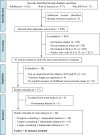Early life adversity and telomere length: a meta-analysis
- PMID: 28322278
- PMCID: PMC5608639
- DOI: 10.1038/mp.2017.26
Early life adversity and telomere length: a meta-analysis
Abstract
Early adversity, in the form of abuse, neglect, socioeconomic status and other adverse experiences, is associated with poor physical and mental health outcomes. To understand the biologic mechanisms underlying these associations, studies have evaluated the relationship between early adversity and telomere length, a marker of cellular senescence. Such results have varied in regard to the size and significance of this relationship. Using meta-analytic techniques, we aimed to clarify the relationship between early adversity and telomere length while exploring factors affecting the association, including adversity type, timing and study design. A comprehensive search in July 2016 of PubMed/MEDLINE, PsycINFO and Web of Science identified 2462 studies. Multiple reviewers appraised studies for inclusion or exclusion using a priori criteria; 3.9% met inclusion criteria. Data were extracted into a structured form; the Newcastle-Ottawa Scale assessed study quality, validity and bias. Forty-one studies (N=30 773) met inclusion criteria. Early adversity and telomere length were significantly associated (Cohen's d effect size=-0.35; 95% CI, -0.46 to -0.24; P<0.0001). Sensitivity analyses revealed no outlier effects. Adversity type and timing significantly impacted the association with telomere length (P<0.0001 and P=0.0025, respectively). Subgroup and meta-regression analyses revealed that medication use, medical or psychiatric conditions, case-control vs longitudinal study design, methodological factors, age and smoking significantly affected the relationship. Comprehensive evaluations of adversity demonstrated more extensive telomere length changes. These results suggest that early adversity may have long-lasting physiological consequences contributing to disease risk and biological aging.
Conflict of interest statement
Figures




References
-
- Children’s Bureau. Child Maltreatment. Human Health and Services; 2012. http://www.acf.hhs.gov/sites/default/files/cb/cm2012.pdf-page=20.
-
- Child Abuse Statistics & Facts. 2016. Accessed Date Accessed 2016 Accessed.
-
- Brown GR, Anderson B. Psychiatric morbidity in adult inpatients with childhood histories of sexual and physical abuse. The American journal of psychiatry. 1991;148(1):55–61. - PubMed
-
- Scott KM, Smith DA, Ellis PM. A population study of childhood maltreatment and asthma diagnosis: differential associations between child protection database versus retrospective self-reported data. Psychosomatic medicine. 2012;74(8):817–823. - PubMed
Publication types
MeSH terms
Grants and funding
LinkOut - more resources
Full Text Sources
Other Literature Sources
Medical
Molecular Biology Databases
Miscellaneous

